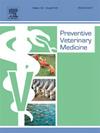PARAMETRA: A transmission modelling database for livestock diseases
IF 2.4
2区 农林科学
Q1 VETERINARY SCIENCES
引用次数: 0
Abstract
Dynamic modelling of infectious diseases of importance to livestock production is a valuable tool for policy and decision makers. Mathematical and simulation models play an essential role in understanding complex systems, but parameterising these models can be challenging, especially in data-sparse environments. When parameters are unable to be estimated from epidemiological or experimental data, a time-consuming and labour-intensive literature review—to identify suitable literature-informed values—is often necessary. In service of this, here we present PARAMETRA, a parameter database for 20 pathogens of livestock, envisaged as an open-source collaborative tool for the research community to aid in the development of future transmission models of livestock pathogens. Pathogens included in the database so far were selected using a disease prioritisation exercise. Parameters of interest were selected by experts with a strong background in epidemiology and mathematical modelling. We populated the database with over 2000 individual values, covering a wide range of different parameters including transmission rates, diagnostic test efficacies, pathogen survival on surfaces, and the farm and regional level prevalences of selected diseases. Finally, we present an initial illustrative analysis of the database contents and the associated metadata of studies included. One of the principal conclusions we can draw from the data available is that in many cases research is reactive, rather than proactive, with research only tending to focus on specific diseases after outbreaks have already occurred, as is the case for African swine fever for example. This has important implications for future research moving to a more proactive approach for experimental and epidemiological studies based on observations of gaps in the data, and high-risk diseases. This publication represents the first step in development for the PARAMETRA database, which will be updated and expanded in the coming years.
参数:家畜疾病传播建模数据库
对牲畜生产具有重要意义的传染病进行动态建模是政策和决策者的宝贵工具。数学和仿真模型在理解复杂系统中起着至关重要的作用,但是参数化这些模型可能具有挑战性,特别是在数据稀疏的环境中。当无法从流行病学或实验数据中估计参数时,通常需要进行耗时且劳力密集的文献综述,以确定合适的文献信息值。为此,我们提出了paramtra,这是一个20种家畜病原体的参数数据库,设想作为研究界的开源协作工具,以帮助开发未来家畜病原体的传播模型。迄今为止,数据库中包括的病原体是使用疾病优先排序练习选择的。感兴趣的参数由具有强大流行病学和数学建模背景的专家选择。我们用超过2000个个体值填充了数据库,涵盖了广泛的不同参数,包括传播率、诊断测试的有效性、病原体在表面上的存活,以及选定疾病的农场和地区一级的患病率。最后,我们对数据库内容和相关元数据进行了初步的说明性分析。我们可以从现有数据中得出的一个主要结论是,在许多情况下,研究是被动的,而不是主动的,研究只倾向于在疫情已经发生之后才关注特定的疾病,例如非洲猪瘟。这对未来的研究具有重要意义,未来的研究将转向更积极主动的方法,根据对数据差距和高风险疾病的观察进行实验和流行病学研究。这份出版物是发展paramtra数据库的第一步,该数据库将在今后几年得到更新和扩大。
本文章由计算机程序翻译,如有差异,请以英文原文为准。
求助全文
约1分钟内获得全文
求助全文
来源期刊

Preventive veterinary medicine
农林科学-兽医学
CiteScore
5.60
自引率
7.70%
发文量
184
审稿时长
3 months
期刊介绍:
Preventive Veterinary Medicine is one of the leading international resources for scientific reports on animal health programs and preventive veterinary medicine. The journal follows the guidelines for standardizing and strengthening the reporting of biomedical research which are available from the CONSORT, MOOSE, PRISMA, REFLECT, STARD, and STROBE statements. The journal focuses on:
Epidemiology of health events relevant to domestic and wild animals;
Economic impacts of epidemic and endemic animal and zoonotic diseases;
Latest methods and approaches in veterinary epidemiology;
Disease and infection control or eradication measures;
The "One Health" concept and the relationships between veterinary medicine, human health, animal-production systems, and the environment;
Development of new techniques in surveillance systems and diagnosis;
Evaluation and control of diseases in animal populations.
 求助内容:
求助内容: 应助结果提醒方式:
应助结果提醒方式:


